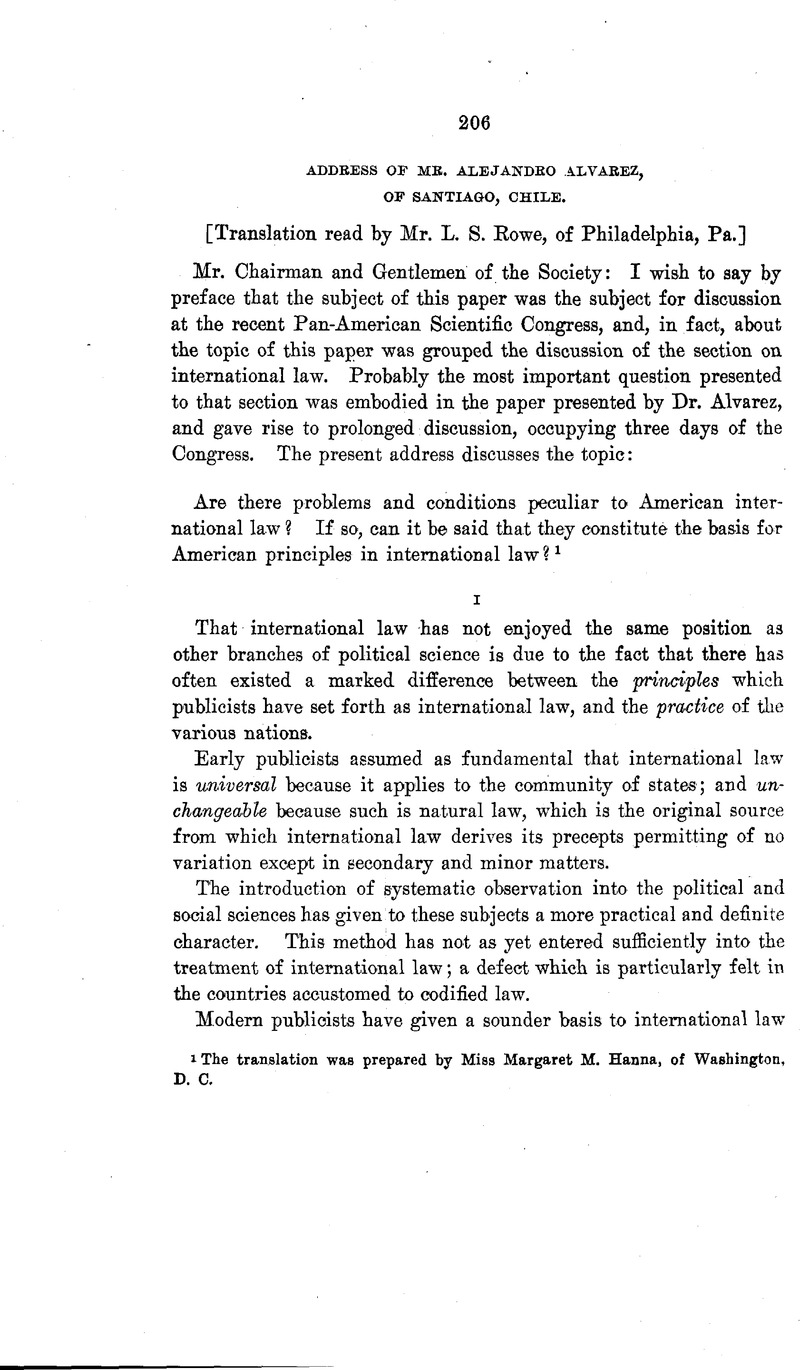No CrossRef data available.
Published online by Cambridge University Press: 27 February 2017

1 The translation was prepared by Miss Margaret M. Hanna, of Washington, D. C.
2 The only phase of the question which has been studied has been the influence of the United States on the development of public law and political institutions. Condorset published in 1786 his work on “ The Influence of the American Revolution on Europe.” In 1896 President Charles W. Eliot, of Harvard University, published a work entitled “American Contributions to Civilization,” (republished in a work of the same title which the author published in 1907, [By The Century Company, New York]). Dr. Muensterberg, also of Harvard University, has criticised the conclusions of Dr. Eliot’s work in a volume entitled “American Traits.”
The first Pan-American Scientific Congress, which met in Santiago, Chile, from December 25, 1908, to January 5, 1909, devoted itself exclusively to the study of problems of American interest along various lines of activity and to determining the best means of elucidating them. The program of the several sections of the Congress, particularly of the social sciences, is a fair showing of the questions characteristic of this hemisphere.
3 Prof. Nys, of the University of Brussels, has recently begun the publication of a study of the influence of the United States on international law, — “Les Etats Unis et le Droit des Gens” in the “Revue de Droit International et de Législation Comparée,” second series, vol. XI, 1909, pp. 37–65.
4 The differences existing between the decisions of European and American States on many points of nationality are discussed in my work “ La Nationalité dans le Droit International Américain.” A. Pedone, Paris: 1907.
5 One acceptation of the term American international law occurs in the collection of concrete precedents in international questions arising in America. Pradier-Fodéré uses the term in that sense in his: “ Traité de Droit International Public Européen et Américain; ” also Seijas, in his: “El Derecho Internacional Hispano-Americano Publico y Privado,” Caracas, 1884.
In the United States certain publicists have collated and classified methodically certain international questions which interest their country and which have been the subject of conventions, diplomatic negotiations, or decisions of Courts of Justice. Such works have likewise been termed American international law works, as: Wharton, “A Digest of the International Law of the United States,” and Moore, “A Digest of International Law,” 8 Volumes, Washington, 1906.
Another acceptation of the term is to compare it to the European international law, to demonstrate that there is an antagonism of interests between the old and the new continents. The declared existence of American international law in this sense naturally provokes lively protestation on the part of the states of the two hemispheres, since it is absurd to. look for or to infer antagonism where solidarity alone is expected. It was understanding the acceptation of the expression in this sense that led certain delegates to the First and Second Pan-American Conferences to deny the existence of the law. See “ International American Conference,” official edition, Washington, 1890, Vol. II, pp. 969–970, also “ Protocols and papers of the Second Pan-American Conference,” Mexico, 1902, Vol. I, pp. 342–348.
In a third acceptation of the term, the solidarity of interests between groups of American States is understood in the use of the expression “ public American law” or “ public South American law.” See preamble of the Treaty of April 20, 1886, between Peru and Bolivia for the settlement of boundaries.
A fourth acceptation of the expression is with regard to international rules which the American states have expressly recognized in Pan-American conferences, giving them great importance. For example: The First Pan-American Conference recognized arbitration; and the second conference recognized the principles contained in the three conventions signed at the First Hague Conference as rules of “ American International Law.”
Lastly, a fifth acceptation of the expression is with regard to rules “tui generis” where it is desired to declare rules peculiarly American. Such a purpose is aimed at by the author of the doctrine known as the “ Drago Doctrine.” See, Drago on “ Les Emprunts d’état et leurs Rapports avec la Politique Internationale,” in the “Revue Générale de Droit International Public,” Vol. XIV, 1907, pages 271 and 287. Cf. Moulin: “La Doctrine de Drago,” in the same Review, Vol. XIV, pp. 466–468.
6 See, on this point, Dupuis: Le Droit de la Guerre Maritime d’Après les Doctrines Anglaise contemporaines. Paris: 1899.
7 The only publicist who has grasped the idea of an “American international law” is Alcorta: Cours de Droit International Public, Vol. I, Paris, 1887 (Preface, Chap. II, No. II, and Chap. IV, No. VI), but he has not expressly affirmed its existence nor indicated its fundemental characteristics, nor much less the factors which constitute it. But even in his Curso de Derecho Internacional Privado (Buenos Aires, 1887) in the chapter on nationality he does not declare the distinctively American characteristics of that question nor its peculiar features in the several nations of this continent.